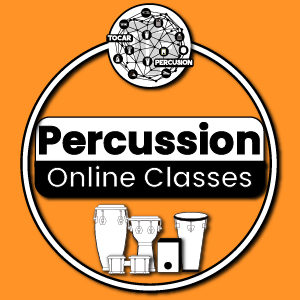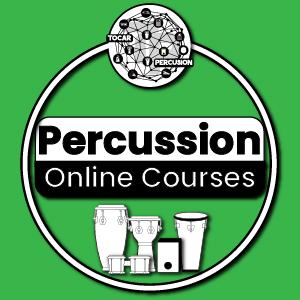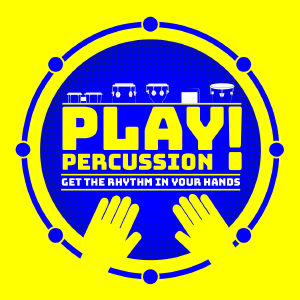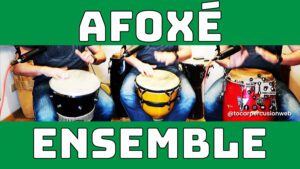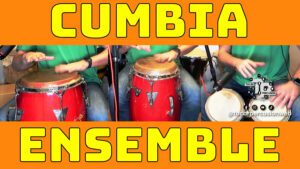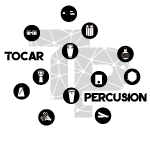Start your learning path in percussion today! Bongo Congas Cajon...
Read MoreStart your learning path in percussion today!
CUMBIA RHYTHM
Percussion Ensemble
CONGA+TUMBADORA+BONGÓ
(Video Tutorials)
Author: Facundo Alvarez, Percussion teacher and Facilitator
Hi, welcome to Tocar Percusión Website.
In this section you´re going to find several post and videos about percussion ensembles of different rhythms from around the world.
This post is dedicated to Colombian Cumbia a rhythm deeply rooted in Colombia´s music and tradition.
In this video you can watch how the modern Cumbia Ensemble is built and which rhythms are played in it.
For the recording of the video I included Conga, Tumbadora and Bongó as main percussion instrument, but in the back you can also listen to some traditional Colombian percussion instrument such as: Maracas and Tambora.
All the rhythms I played in the video are inspired in the traditional rhythms played by the original drums from Cumbia like: “Tambor Alegre” and “Llamador”.
This material is part of the contents that I use on my Percussion Online Classes and Courses.
I hope you find them useful and entretaining
Thanks to visit my website
Facundo Alvarez
Learn to play percussion online
¡Choose the way to learn to Play Percussion
that best suits your times and needs!
Learn to Play Percussion: Bongó, Conga, Cajón, Djembé, Timbal Brasilero
Percussion Online Classes
In the Online Percussion Classes, I offer individual and face to face classes for you to start learn to play percussion from scratch and learn to play and make music with the percussion instrument you like – Bongó, Cajón, Conga, Djembé or Timbal Brasilero.
Percussion Online Courses
In the Percussion Online Courses I offer you different virtual and self-paced courses options for you to start playing percussion from scratch and develop yourself as percussionist. Courses include several percussion instrument such as: Bongo, Cajón, Conga, Djembé or Timbal Brasilero.
Percussion Online Group Classes
In the Percussion Online Group Classes I offer grupal and face to face classes for you to start learn to play percussion from scratch and learn to play and make music with the percussion instrument you like – Bongó, Cajón, Conga, Djembé or Timbal Brasilero.
Activities suitable to all ages and levels
You don´t need to have previous knowledges of music or percussion to get started.
Colombian Cumbia Rhythm
Tracing the Echoes of African and Indigenous Heritage

Cumbia and Colombian Music
Colombia, a country known for its diverse cultural landscape, offers a rich tapestry of musical traditions. One of the most enchanting rhythms to emerge from this vibrant nation is the Colombian Cumbia. Rooted in a fusion of African, Indigenous, and Spanish influences, Cumbia is a celebration of Colombia’s historical and cultural journey.
The Origins and Historical Significance
Cumbia’s origin story is a testament to Colombia’s multicultural heritage. Emerging from the coastal regions of Colombia during the colonial period, Cumbia reflects the interaction between African slaves, Indigenous peoples, and Spanish colonizers. The word “Cumbia” is believed to have been derived from the Kumbé ritual dance of West African descent, signifying a spiritual connection to the rhythm.
Key Elements of Colombian Cumbia
 1. Drumming: The heartbeat of Cumbia lies in its rhythmic drumming. Drums like the “tambora” and “llamador” set the tempo, while the “tambor alegre” adds intricate patterns. The blend of African and Indigenous drumming techniques creates a unique syncopation that drives the dance.
1. Drumming: The heartbeat of Cumbia lies in its rhythmic drumming. Drums like the “tambora” and “llamador” set the tempo, while the “tambor alegre” adds intricate patterns. The blend of African and Indigenous drumming techniques creates a unique syncopation that drives the dance.
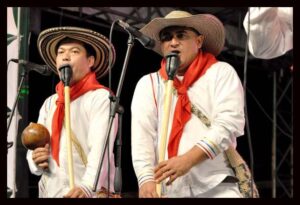 2. Melodic Instruments: Cumbia melodies are often carried by instruments like the gaita, a traditional Indigenous flute, and the cumbia tambora, a drum with a cylindrical resonator. These instruments contribute to the distinctive fusion of sounds that define Cumbia.
2. Melodic Instruments: Cumbia melodies are often carried by instruments like the gaita, a traditional Indigenous flute, and the cumbia tambora, a drum with a cylindrical resonator. These instruments contribute to the distinctive fusion of sounds that define Cumbia.
 3. Dance: Cumbia is not just music; it’s also a dance that mirrors the rhythm’s history. Dancers move in a circular motion, representing the union of different cultures. The swaying of the hips, the handkerchief twirls, and the intricate footwork all contribute to the visual storytelling of Cumbia.
3. Dance: Cumbia is not just music; it’s also a dance that mirrors the rhythm’s history. Dancers move in a circular motion, representing the union of different cultures. The swaying of the hips, the handkerchief twirls, and the intricate footwork all contribute to the visual storytelling of Cumbia.
Cultural Significance
Cumbia has deep cultural roots and serves as a representation of Colombia’s identity. It’s a bridge that connects various communities and regions, transcending social and geographical boundaries. Cumbia dances and music are integral to festivals, celebrations, and cultural events, symbolizing unity and shared heritage.
Colombian Cumbia main artists
Colombian cumbia is a vibrant tapestry woven with the threads of rich musical traditions. Let’s celebrate some of the best and most famous players and singers who have contributed to this cultural treasure!
🥁 Lucho Bermúdez: Known as the “Maestro of Cumbia,” Bermúdez’s innovative arrangements and virtuoso clarinet playing revolutionized cumbia, earning him a spot in the pantheon of Colombian musical legends.
🎤 Totó la Momposina: Hailing from the Caribbean coast, Totó’s powerful voice and mastery of traditional rhythms have earned her international acclaim. Her music is a testament to the resilience and beauty of Colombian folk traditions.
🪕 Carlos Huertas: An accomplished guitarist, Huertas’s delicate touch and intricate melodies have graced numerous cumbia compositions. His virtuosity on the strings has left an indelible mark on the genre.
🎺 Paito y los Gaiteros de Punta Brava: Paito’s dynamic gaita (indigenous flute) playing combined with the energetic rhythms of his band create a lively fusion of sounds that have captivated audiences around the world.
🎶 Petrona Martínez: Hailing from the Caribbean city of Cartagena, Petrona’s soul-stirring voice and deep connection to Afro-Colombian traditions have made her an emblematic figure in the world of cumbia.
🥁 Grupo Bahía: This ensemble, formed in the 1940s, is celebrated for its seamless fusion of indigenous, African, and Spanish influences. Their rhythmic prowess and spirited performances continue to captivate audiences to this day.
🎵 Aníbal Velásquez: Known as “El Mago” (The Magician), Velásquez’s accordion virtuosity has elevated him to legendary status. His playful melodies and infectious rhythms have made him a beloved figure in Colombian music.
Colombian Cumbia in Contemporary Times
While Cumbia holds steadfast to its traditions, it has also evolved over time. Modern artists and musicians are reimagining Cumbia by infusing it with contemporary elements, blending it with other genres, and experimenting with new sounds. This evolution ensures that Cumbia remains relevant to new generations while retaining its historical essence.
Check this Percussion Ensembles
🔥 Tondero Rhythm | Percussion Ensemble 🔥 Cajón + Conga + Bongó (Video Tutorial)
Start your learning path in percussion today! Bongo Congas Cajon...
Read More🔥 Cumbia Rhythm | Percussion Ensemble 🔥 Conga + Tumbadora + Bongó (Video Tutorial)
Start your learning path in percussion today! Bongo Congas Cajon...
Read Morepercussion facilitator
Facundo Alvarez
Percussion Facilitator
For 20 years I´ve dedicated myself to develope educational and recreational materials and experiences, with the goal of facilitate access to percussion learning to people of all ages
In all the projects I work motivated by the premise that "Percussion is for everybody" and that "Everyone can learn to play percussion".
My main goal is to help, as many people as I can, to live the unique experience of making music with percussion instruments.
